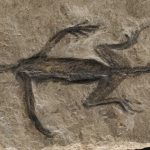A harsh lesson for paleontology: What was believed to be the oldest fossil found in the Alps, attributed to a 280 million-year-old reptile and discovered in 1931 in the Italian Alps, has been unmasked as a partial forgery.
This find, which was long considered a valuable Tridentinosaurus antiquus for the study of the evolution of early reptiles, has been the subject of a critical reevaluation by researchers at University College Cork in Ireland.
For decades, the fossil was acclaimed for its apparent preservation of soft tissue, an extraordinary feature that classified it within the Protorosauria group of reptiles. However, the somewhat strange conservation of the fossil had left many experts with doubts about which group of reptiles the lizard-like specimen belonged to and also many unknowns about its geological history.
Fossilized skin turned out to be paint
Recent research, published in the scientific journal Palaeontology, has revealed that the body contour of Tridentinosaurus antiquus was created artificially, probably to improve the appearance of the fossil, a deception that for decades confused researchers who had studied the fossil. What was thought to be fossilized skin is nothing more than black paint on a rock surface carved into the shape of a lizard.
A preliminary investigation with UV photography showed that the specimen had been coated with some type of material, which was not unusual because in the past it was common to cover them with varnishes or lacquers to preserve them in museum display cases.
The team hoped that, under the coating layer, the original soft tissues would still be in good condition to extract meaningful paleobiological information. But it was not like that.
Not everything is lost
The research team, which includes collaborators from the University of Padua, the South Tyrol Museum of Nature and the Museo delle Scienze in Trento, has called for caution in cataloging ancient remains.
Despite the disappointment of discovering the fake, the study does not conclude with a completely negative verdict.
The researchers found that certain elements of the fossil, such as the bones of the hind limbs and small bony scales known as osteoderms, are authentic, although poorly preserved.



:strip_icc()/i.s3.glbimg.com/v1/AUTH_59edd422c0c84a879bd37670ae4f538a/internal_photos/bs/2023/l/E/HqZei9QOAb9MBIFxnlag/dsc-1634.jpg?w=150&resize=150,150&ssl=1)



